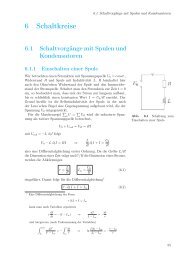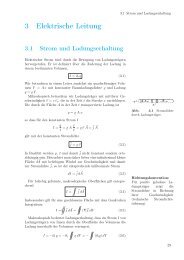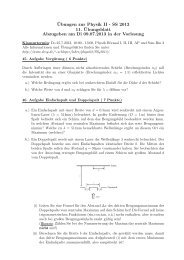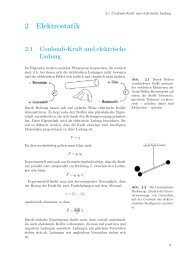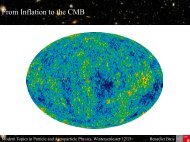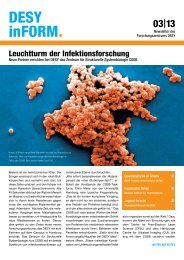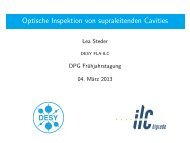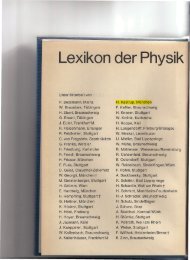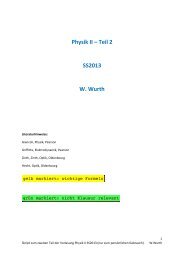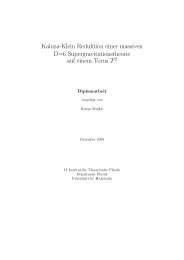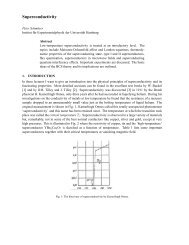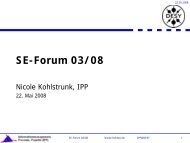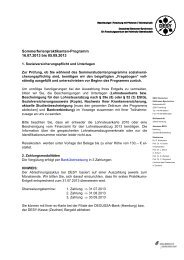Transparencies pdf - Desy
Transparencies pdf - Desy
Transparencies pdf - Desy
Create successful ePaper yourself
Turn your PDF publications into a flip-book with our unique Google optimized e-Paper software.
P H Y S I C A L R E V I E W L E T T E R S week ending<br />
17 JUNE 2005<br />
lative transverse moentation<br />
is performed<br />
in PYTHIA [18]. This<br />
CD event generator,<br />
utations (Sibyll v2.1<br />
peripheral collisions<br />
f the nucleus is not<br />
ron-nucleus collision<br />
ade equations which<br />
the air shower [20].<br />
ntation are published<br />
before discussing res,<br />
such as the variable<br />
ed predominantly by<br />
region, since this is<br />
d to number of partiton-air<br />
reactions at<br />
model deposits about<br />
the region xF > 10 3<br />
ent of forward quark<br />
n the saturation mo-<br />
tered quarks fragment<br />
imum x F. In contrast,<br />
leading diquark with<br />
momentum. This core<br />
when the saturation<br />
X max [g/cm 2 ]<br />
850<br />
800<br />
750<br />
700<br />
650<br />
600<br />
550<br />
10 8<br />
Sibyll (proton,Iron)<br />
BBL running coupling (proton)<br />
BBL fixed coupling (proton)<br />
Hires Stereo data<br />
p<br />
10 9<br />
energy [GeV]<br />
Fe (Sibyll only)<br />
10 10<br />
Seneca 1.2<br />
10 11<br />
FIG. 1 (color online). Mean Xmax as a function of primary<br />
energy for the pQCD model Sibyll (proton and iron primaries),<br />
the saturation model BBL (proton primaries, fixed- and runningcoupling<br />
evolution of Qs), and the Hires stereo data [1].<br />
Mean Xmax as a function of primary energy for the pQCD model Sibyll<br />
(proton and iron primaries), the saturation model BDL (proton primaries,<br />
fixed- and running- coupling evolution of Q corresponding to the disk body<br />
limit), and the Hires stereo data .<br />
PRL 94, 231801 (2005)<br />
This is due to the ‘‘breakup’’ of the projectile’s coherence<br />
[15] together with the suppression of forward parton scattering<br />
(for central collisions). The comparison to the data<br />
suggests High-Density a light QCDcomposition and Cosmic-Ray Air Showers at those energies. Although<br />
H. J. Drescher, the curve for running-coupling evolution appears to be<br />
parallel to that from Sibyll, the two curves actually approach<br />
at lower energies.<br />
1 A. Dumitru, 1 and M. Strikman 2<br />
P H Y S I C A L R E V I E W L E T T E R S week ending<br />
17 JUNE 2005<br />
1<br />
Johann Wolfgang Goethe University, Postfach 11 19 32, 60054 Frankfurt, Germany<br />
(Received 18 August 2004; published 15 June 502005)<br />
2 Department of Physics, Pennsylvania State University, University Park, Pennsylvania 16802, USA<br />
We discuss particle production in the high-energy, small-x limit of QCD where the gluon density of<br />
hadrons is expected to become nonperturbatively large. Strong modifications of the phase-space distribution<br />
of produced particles as compared to leading-twist models are predicted, which reflect in the<br />
50



